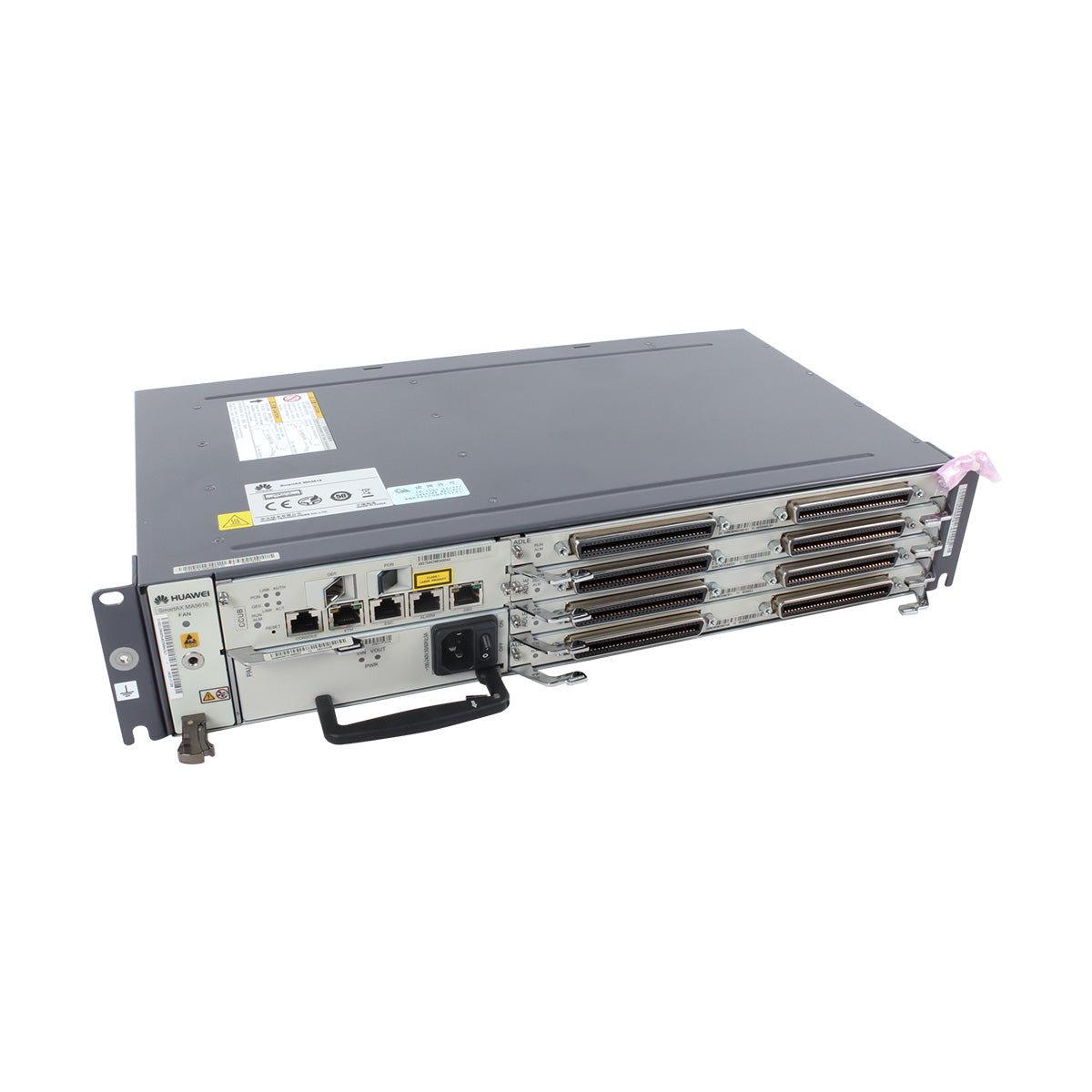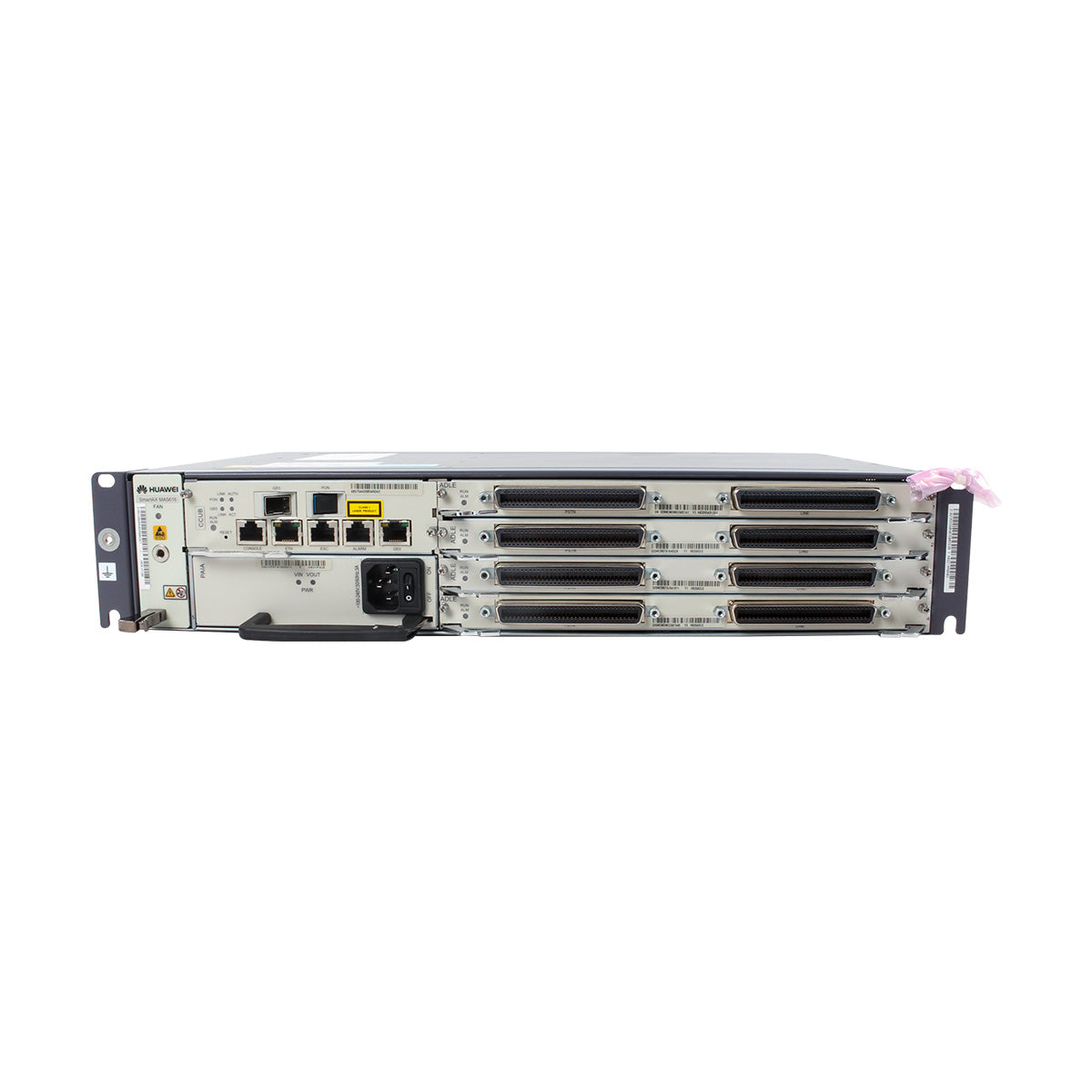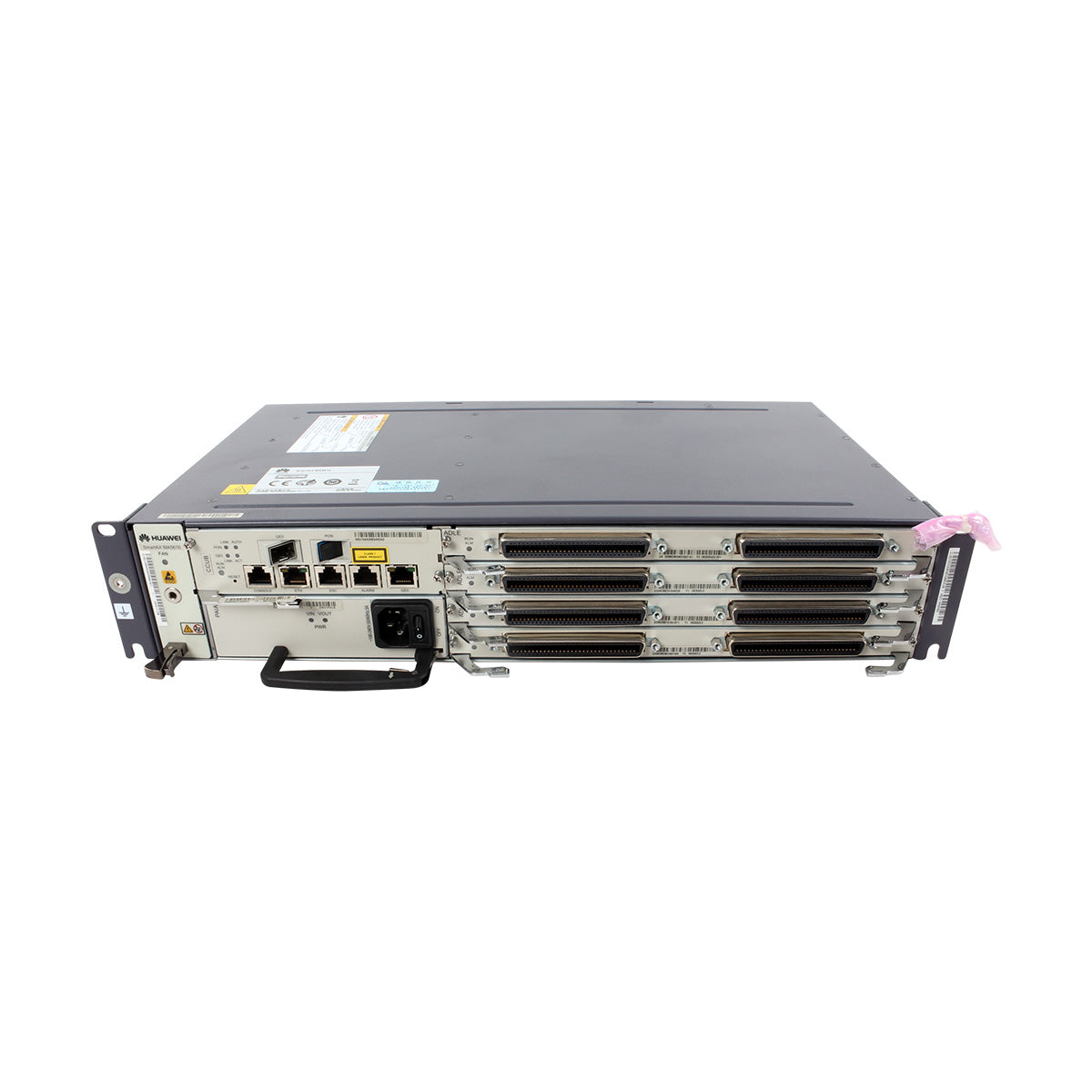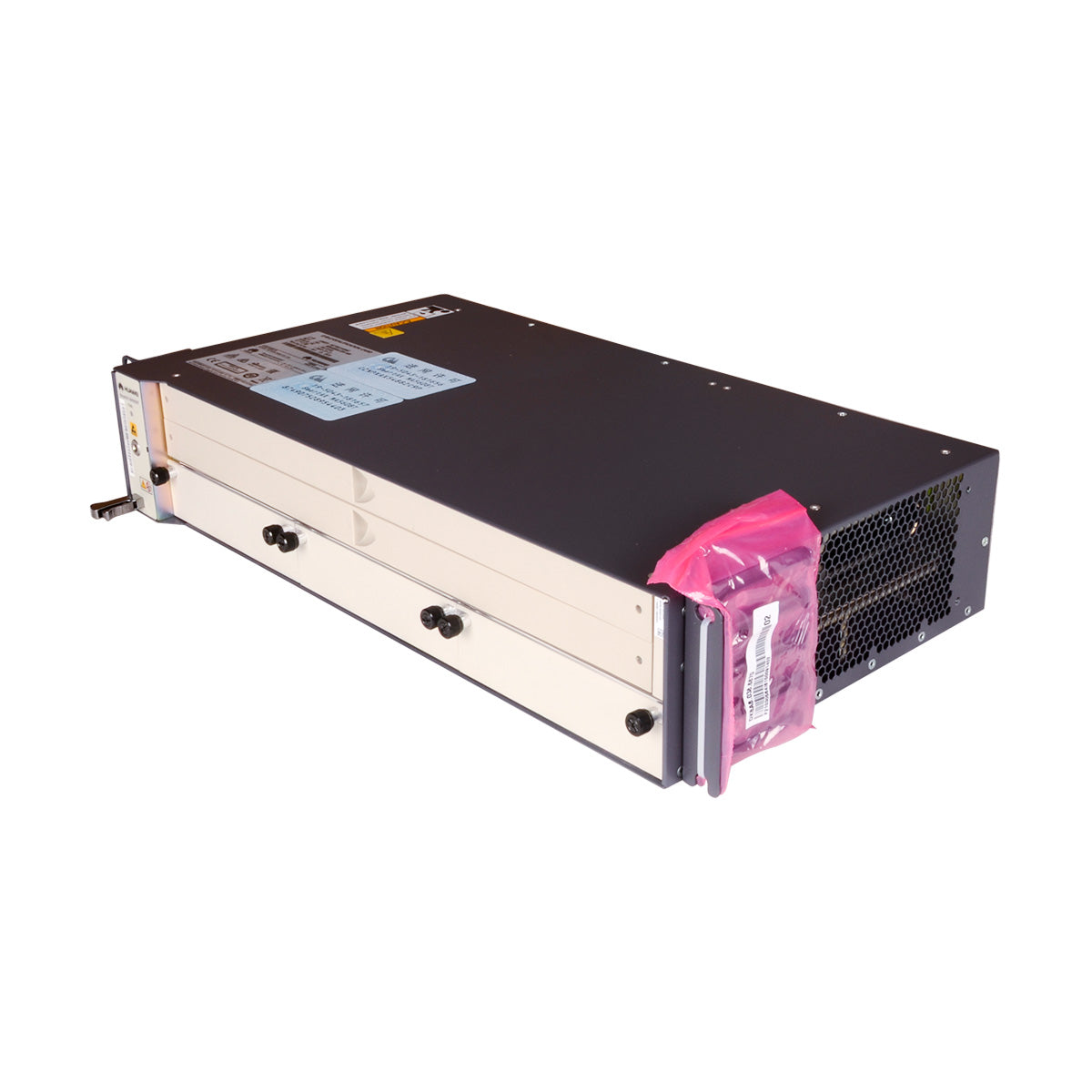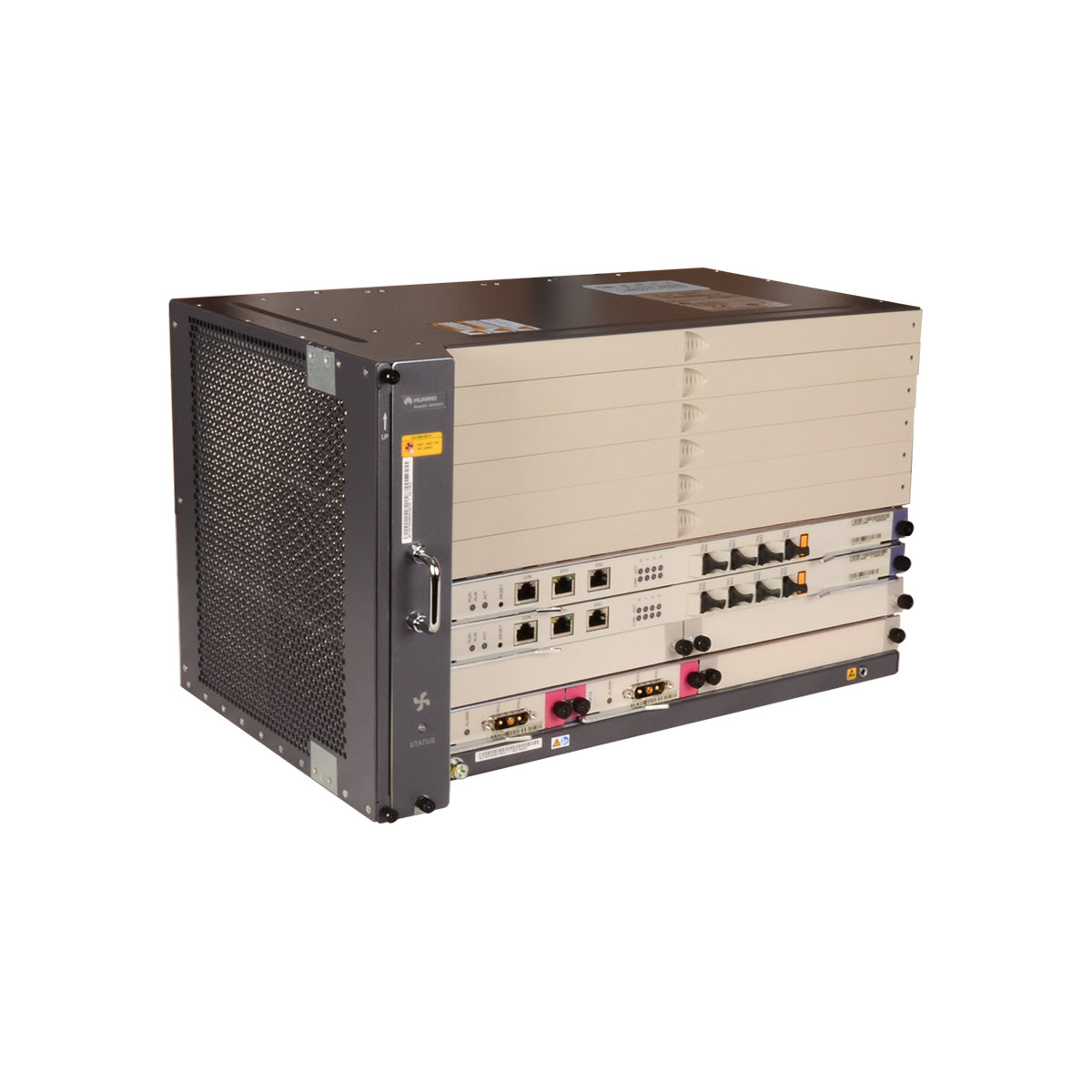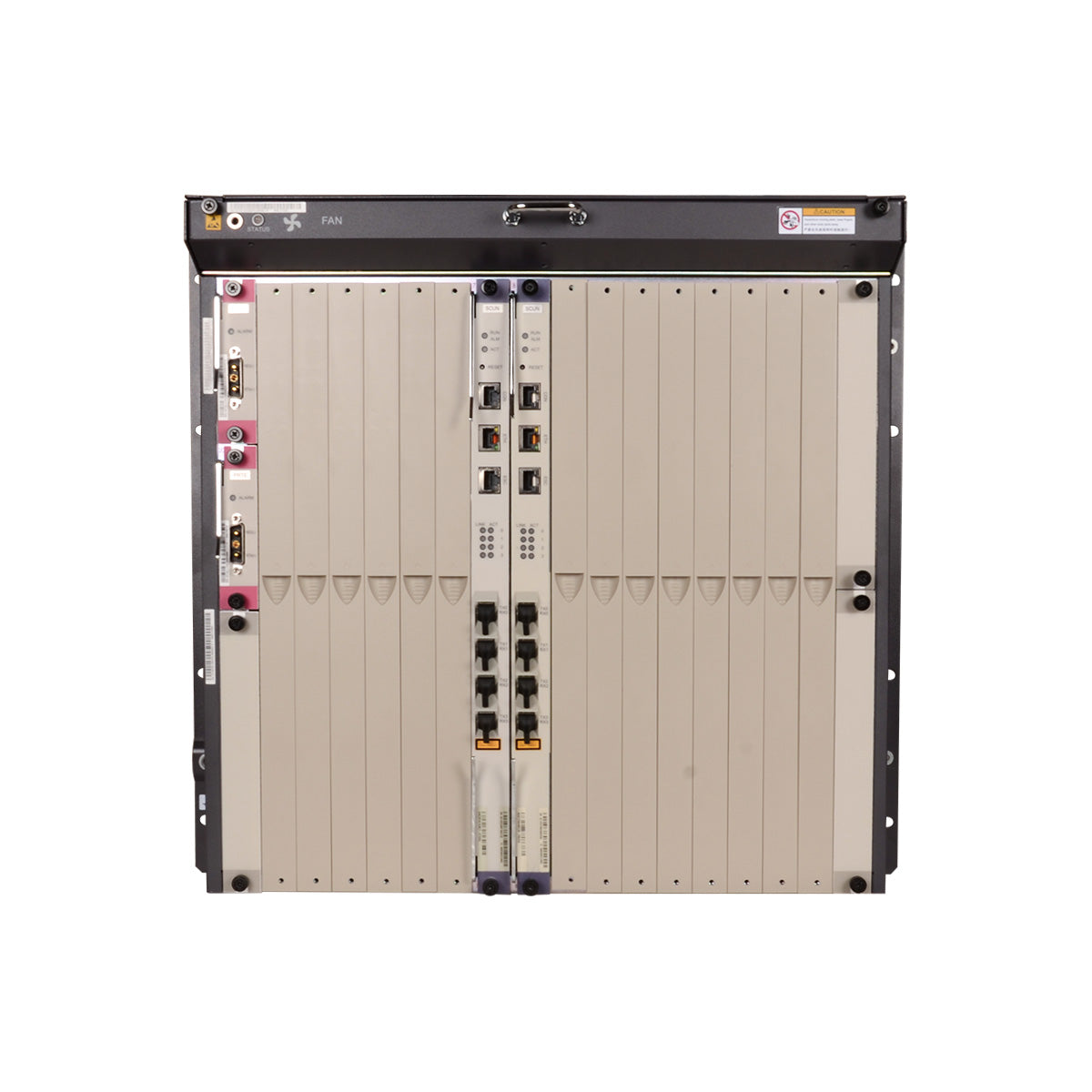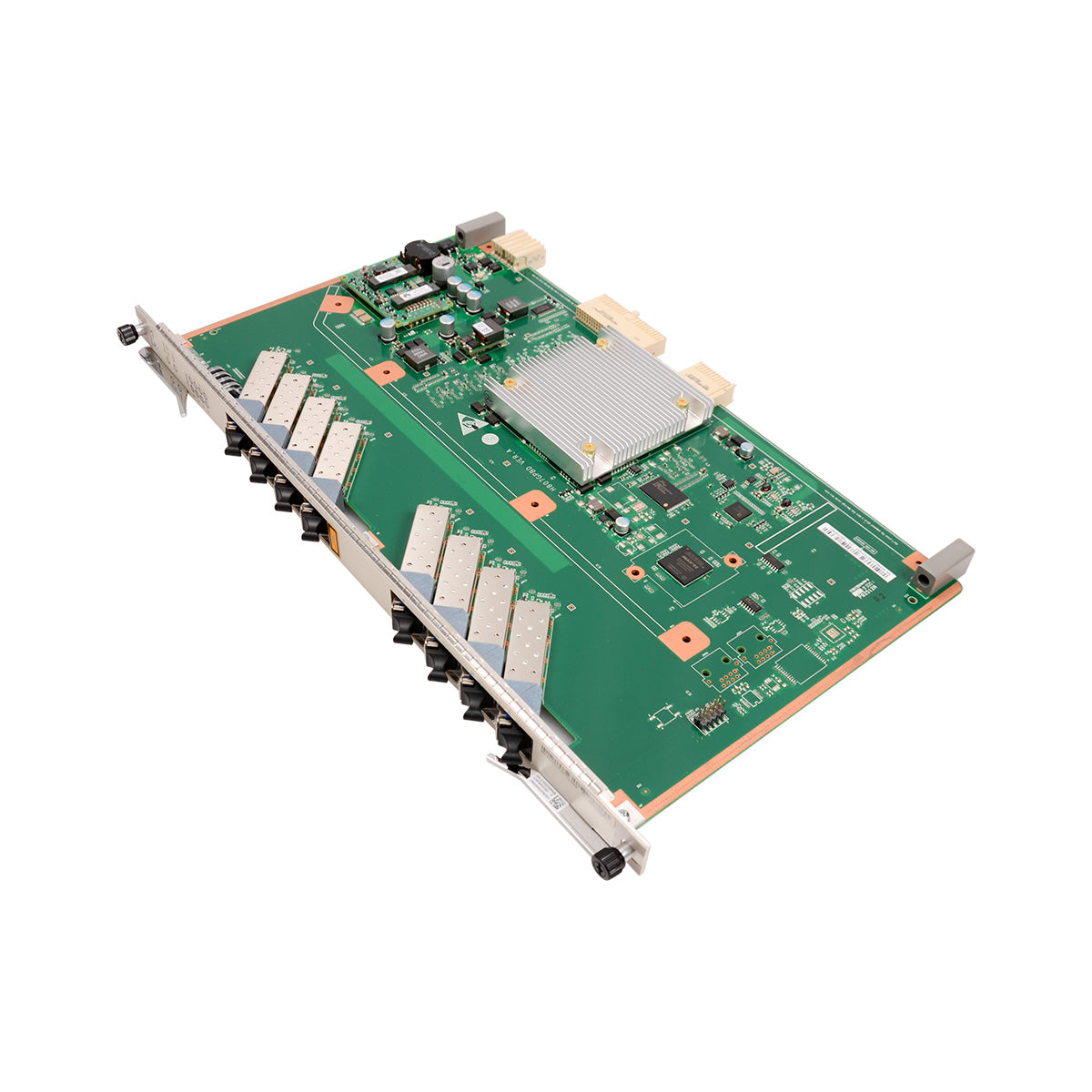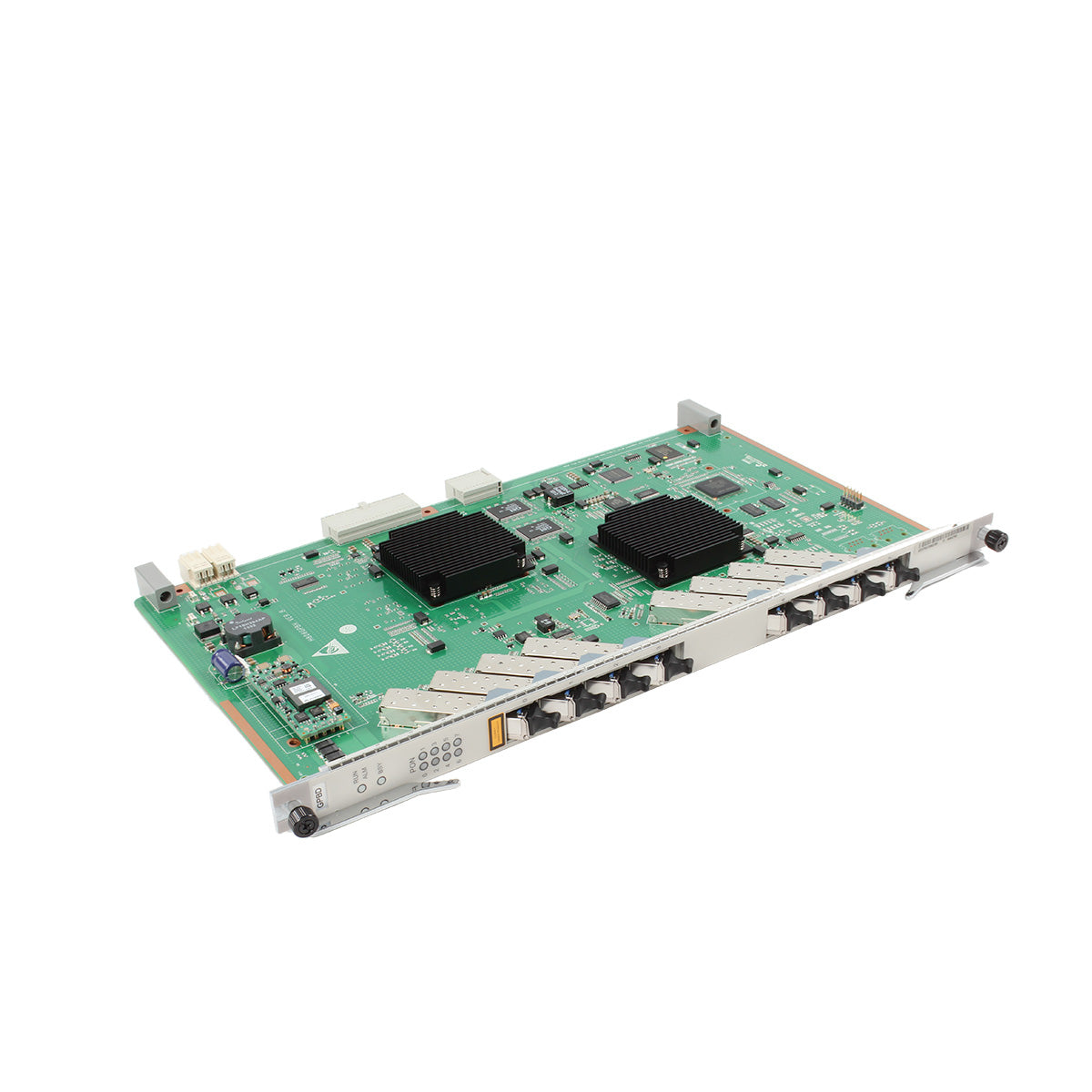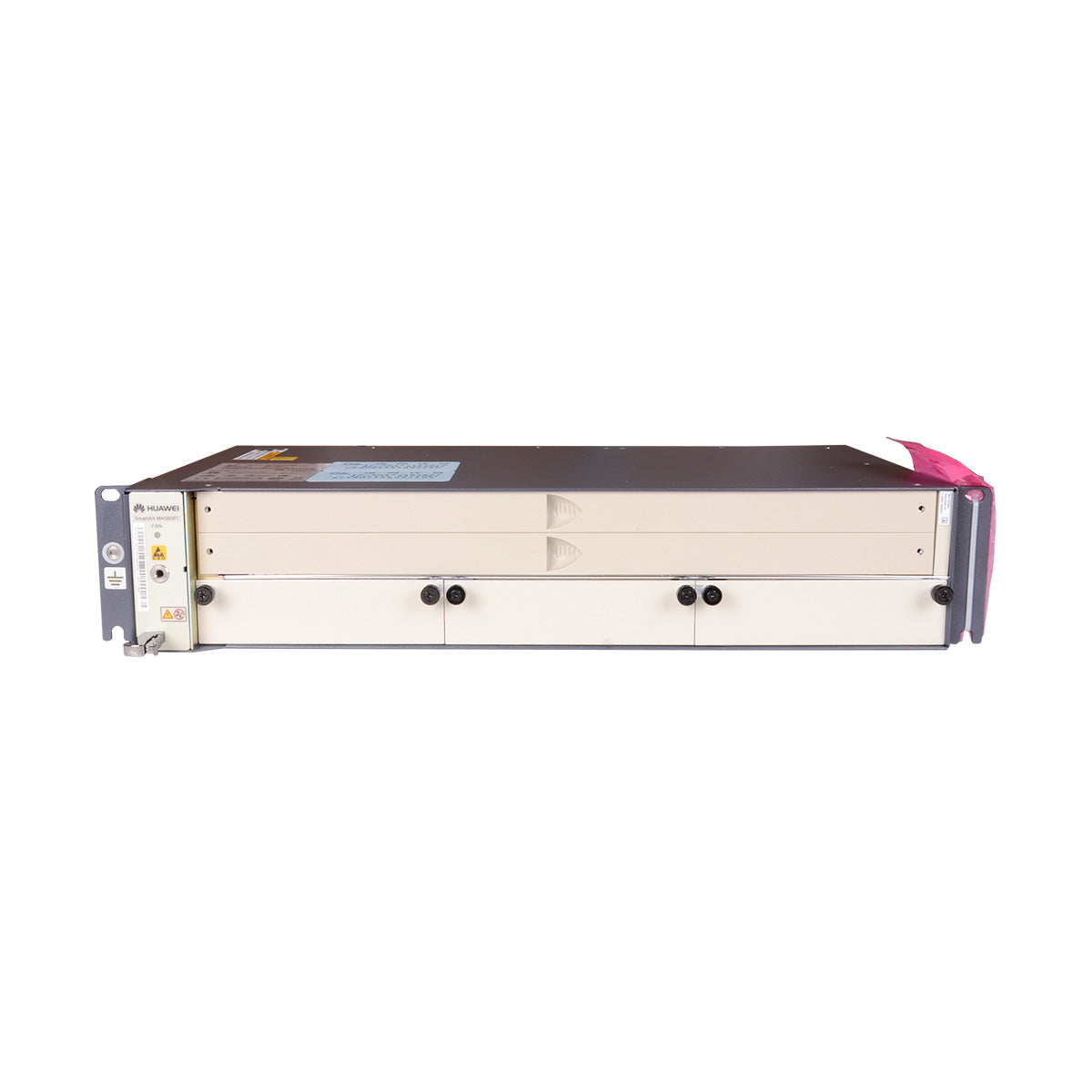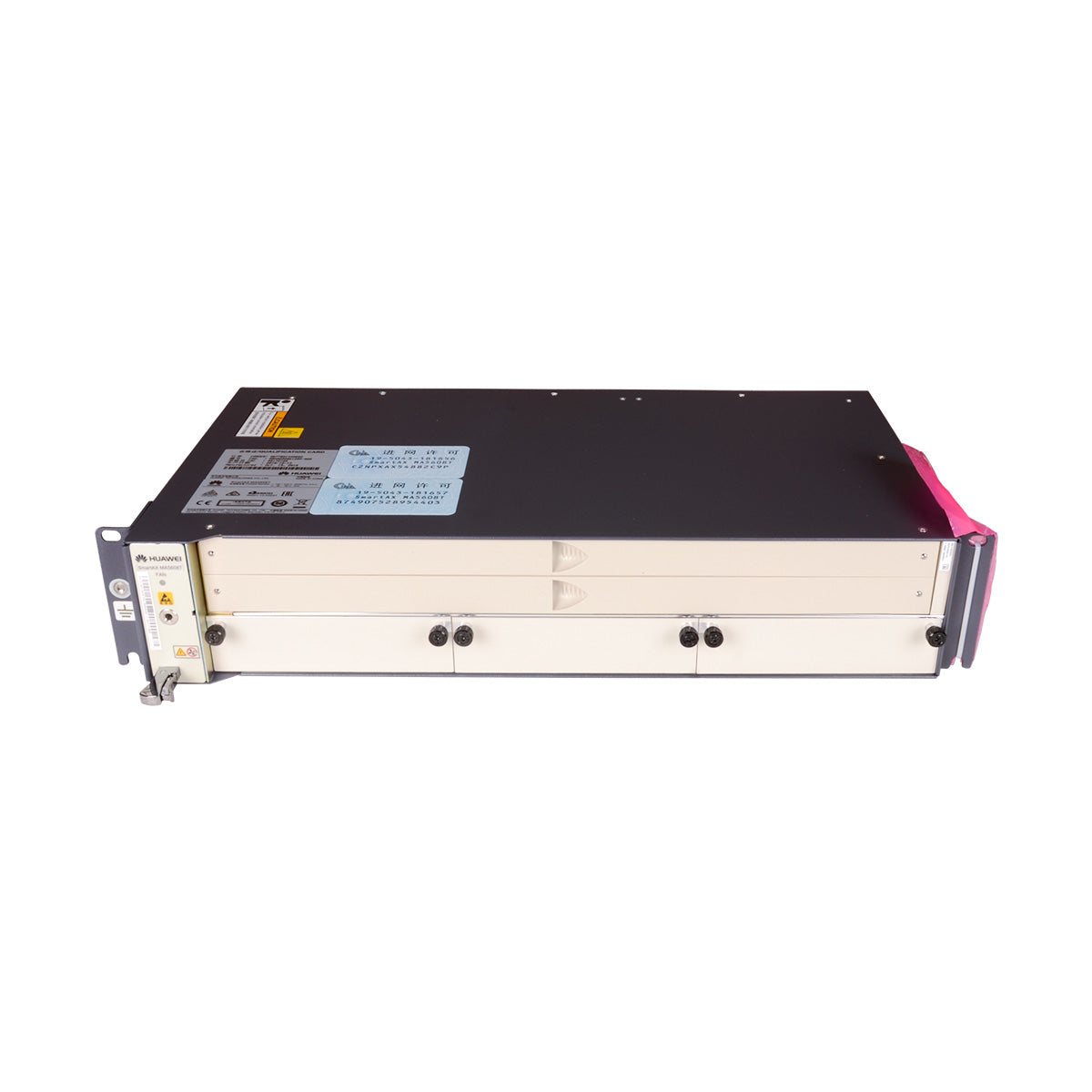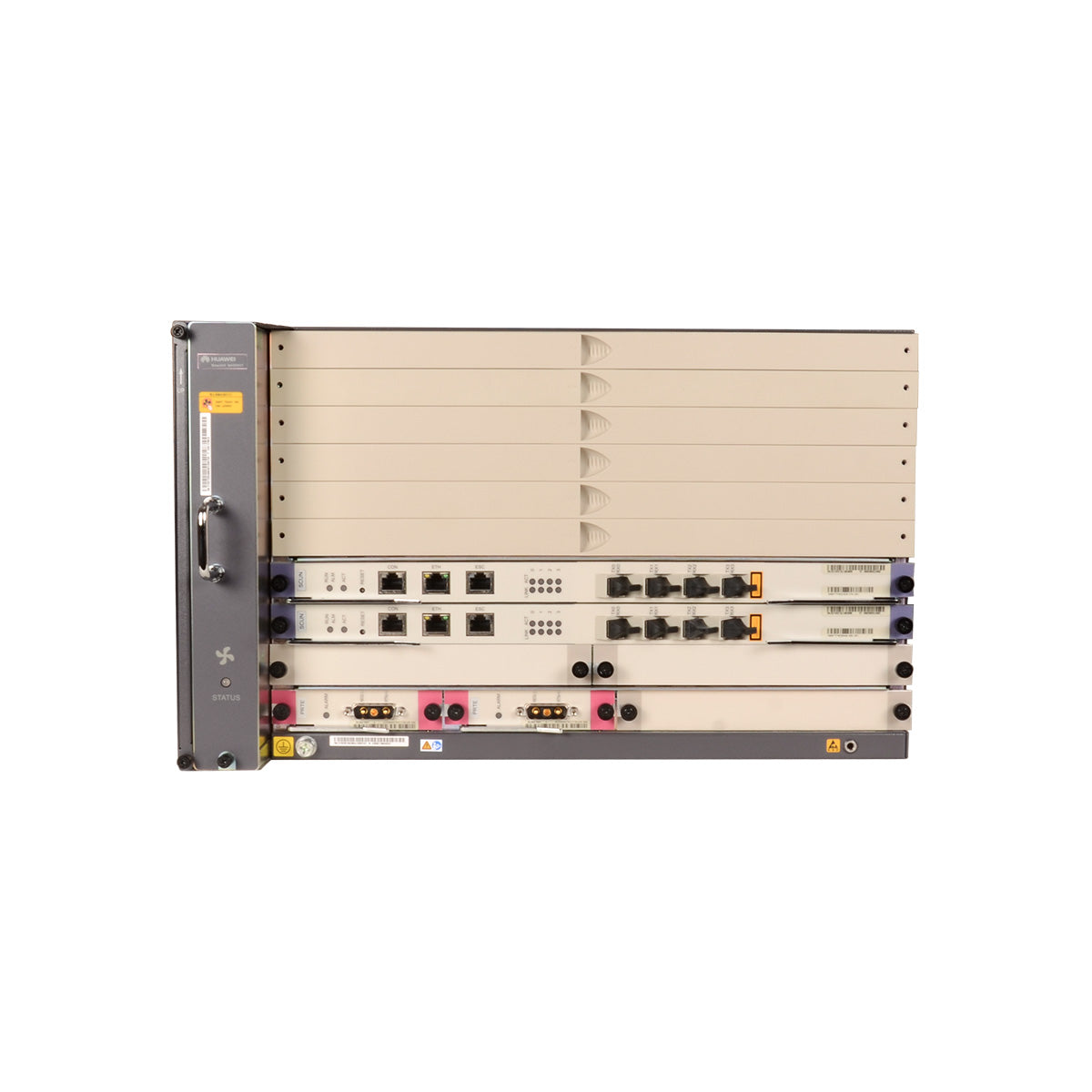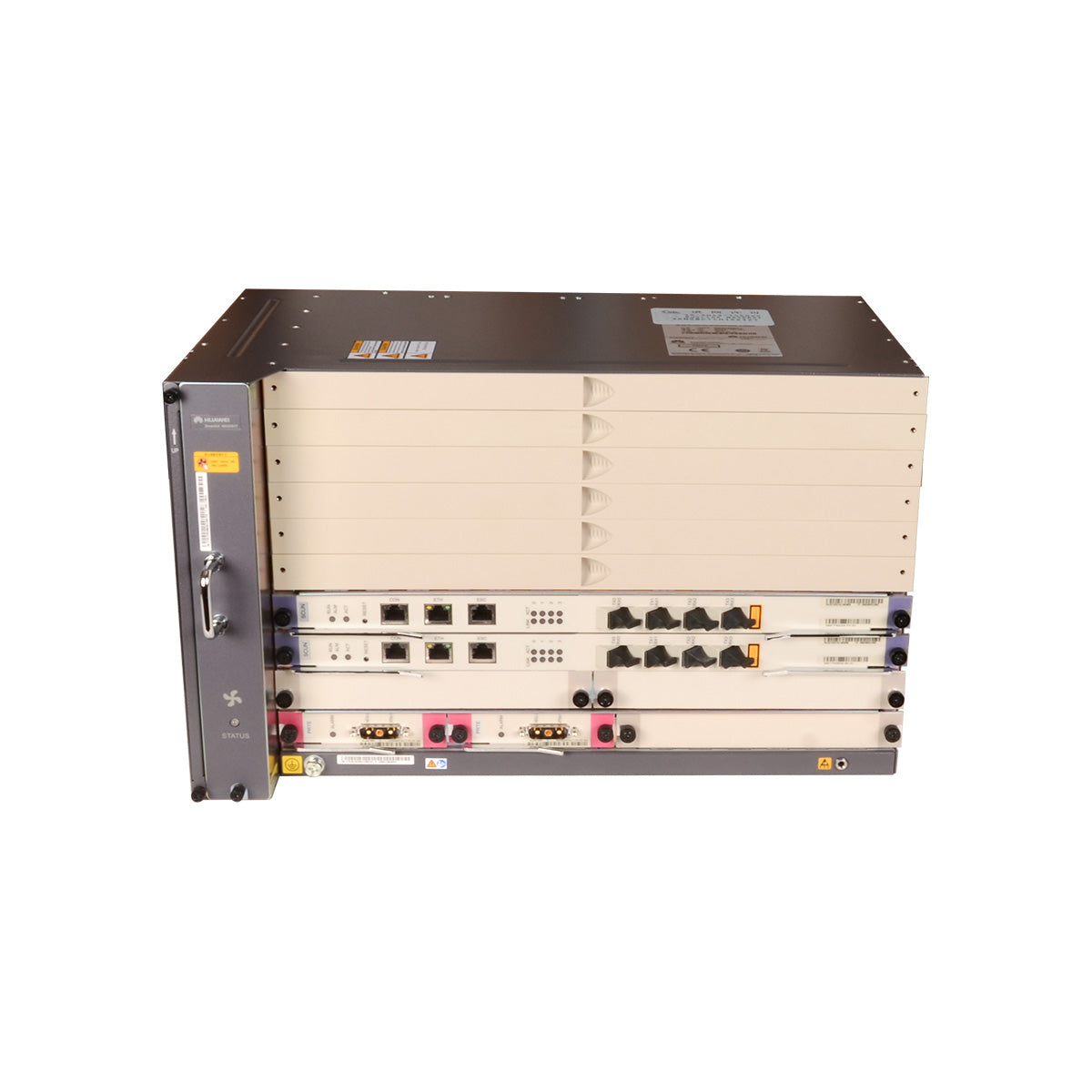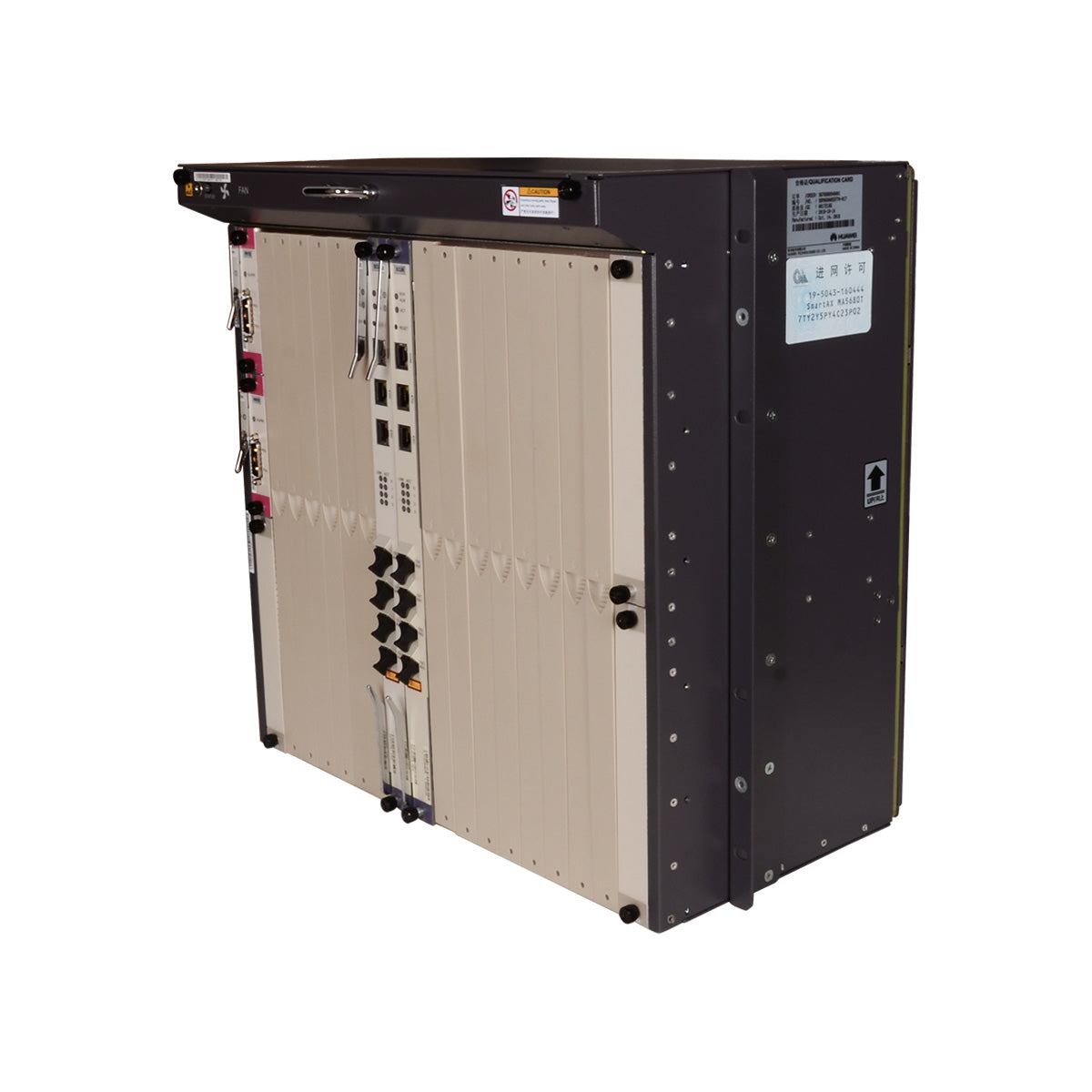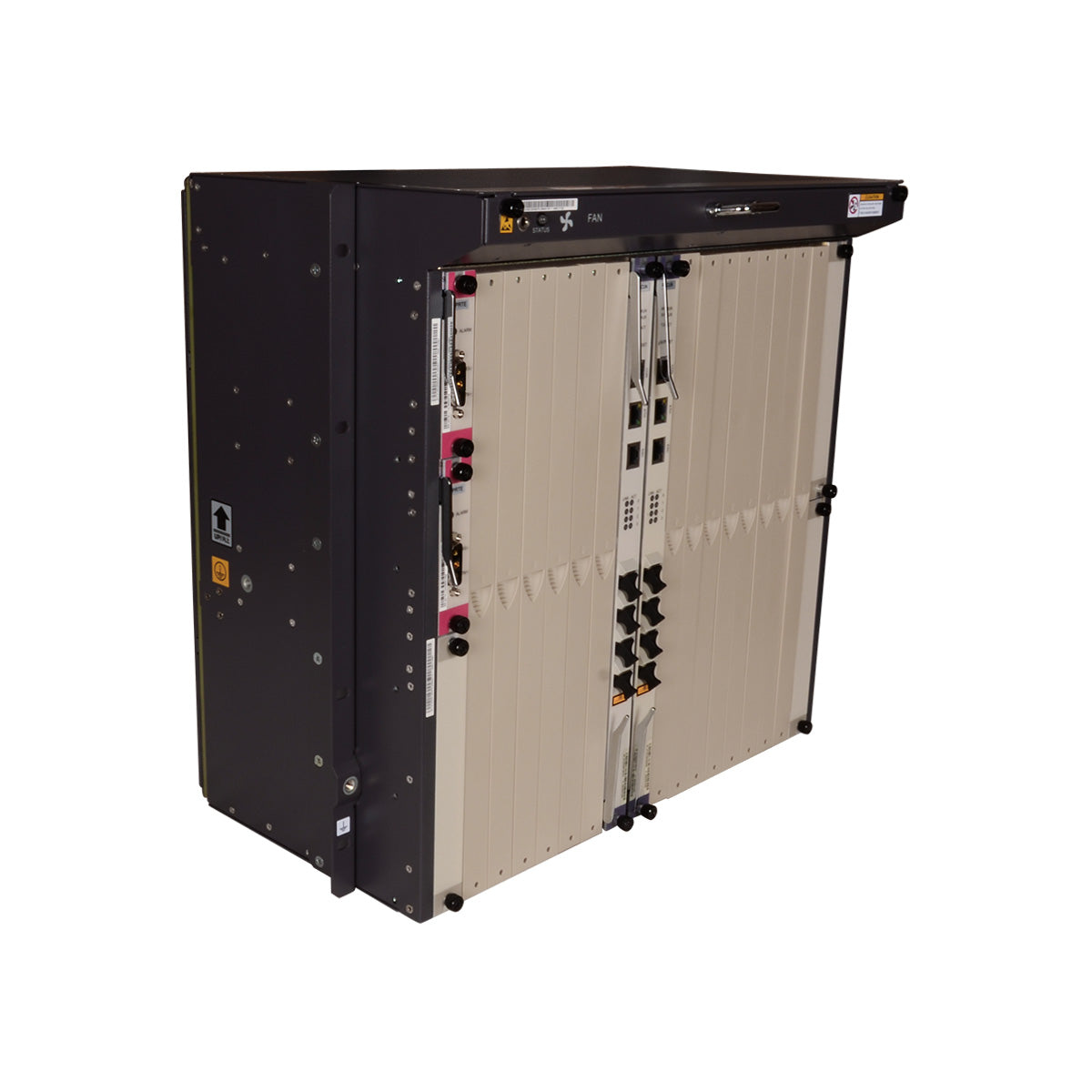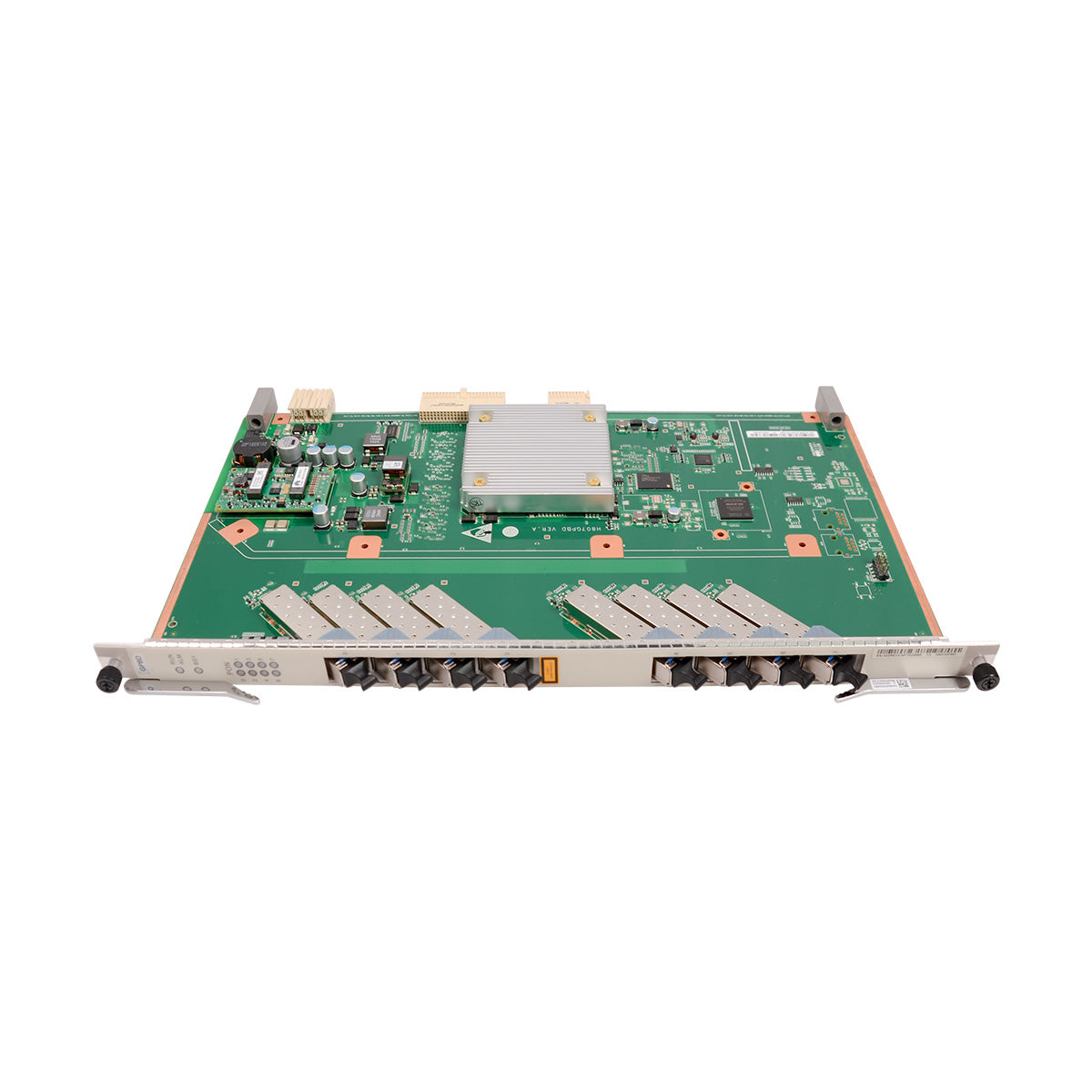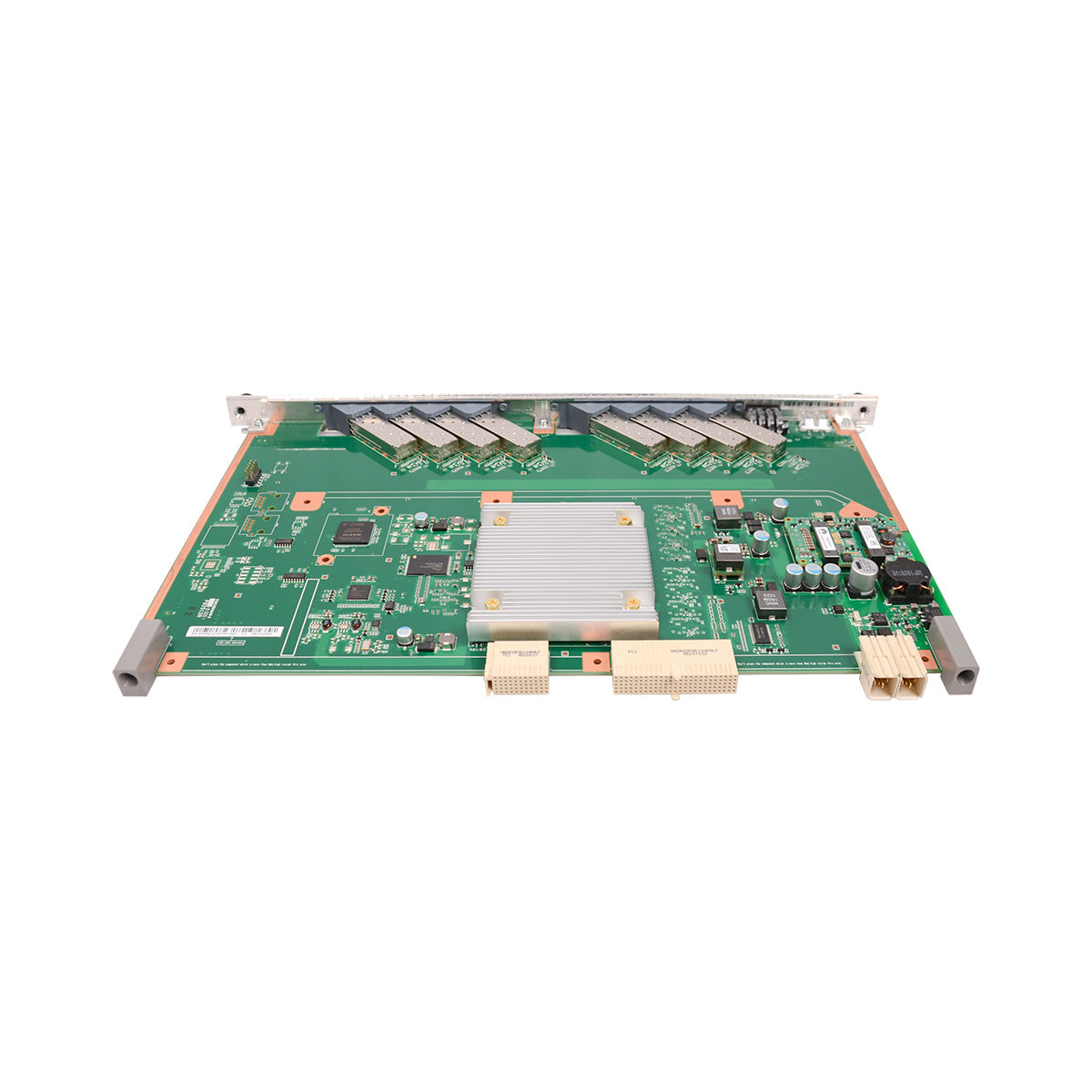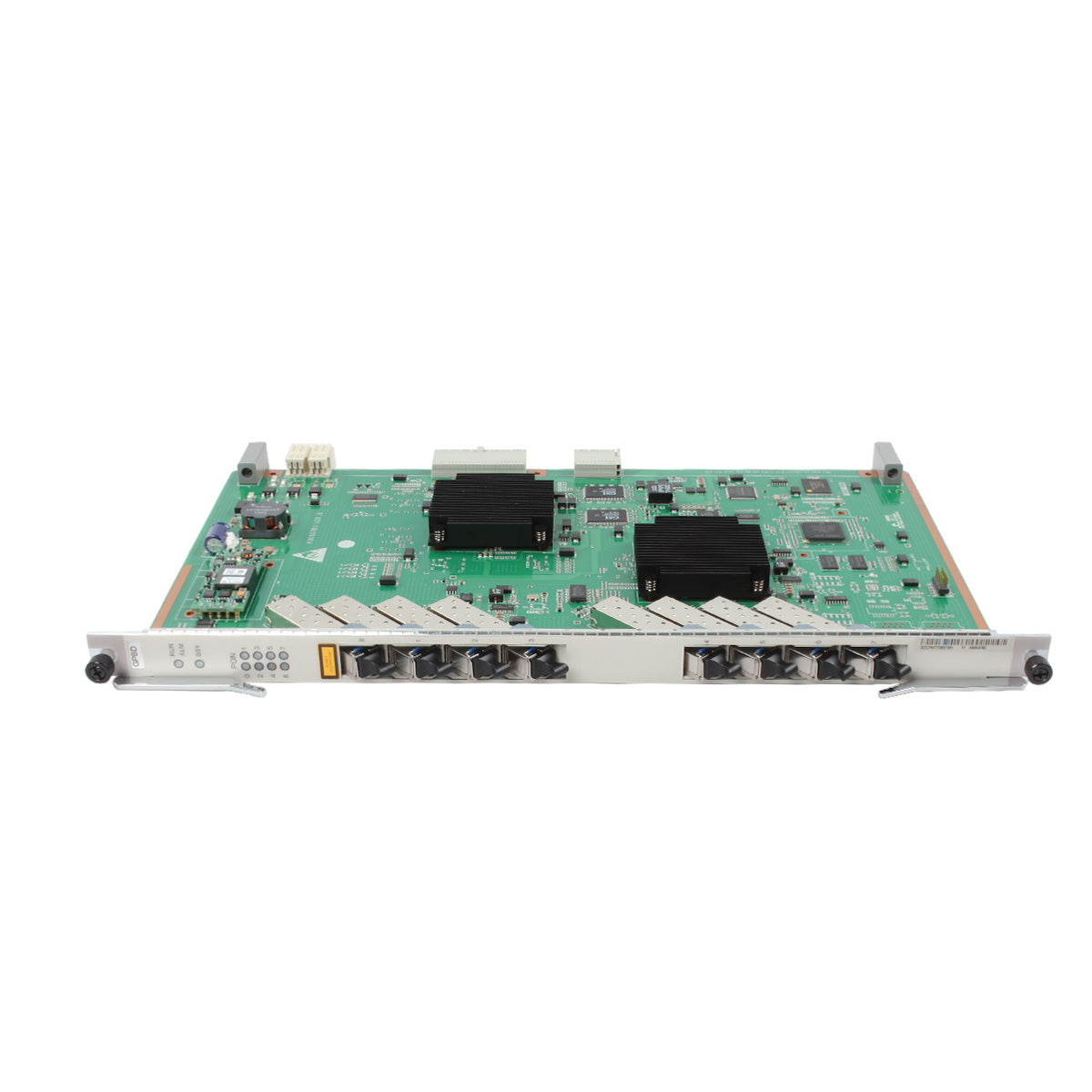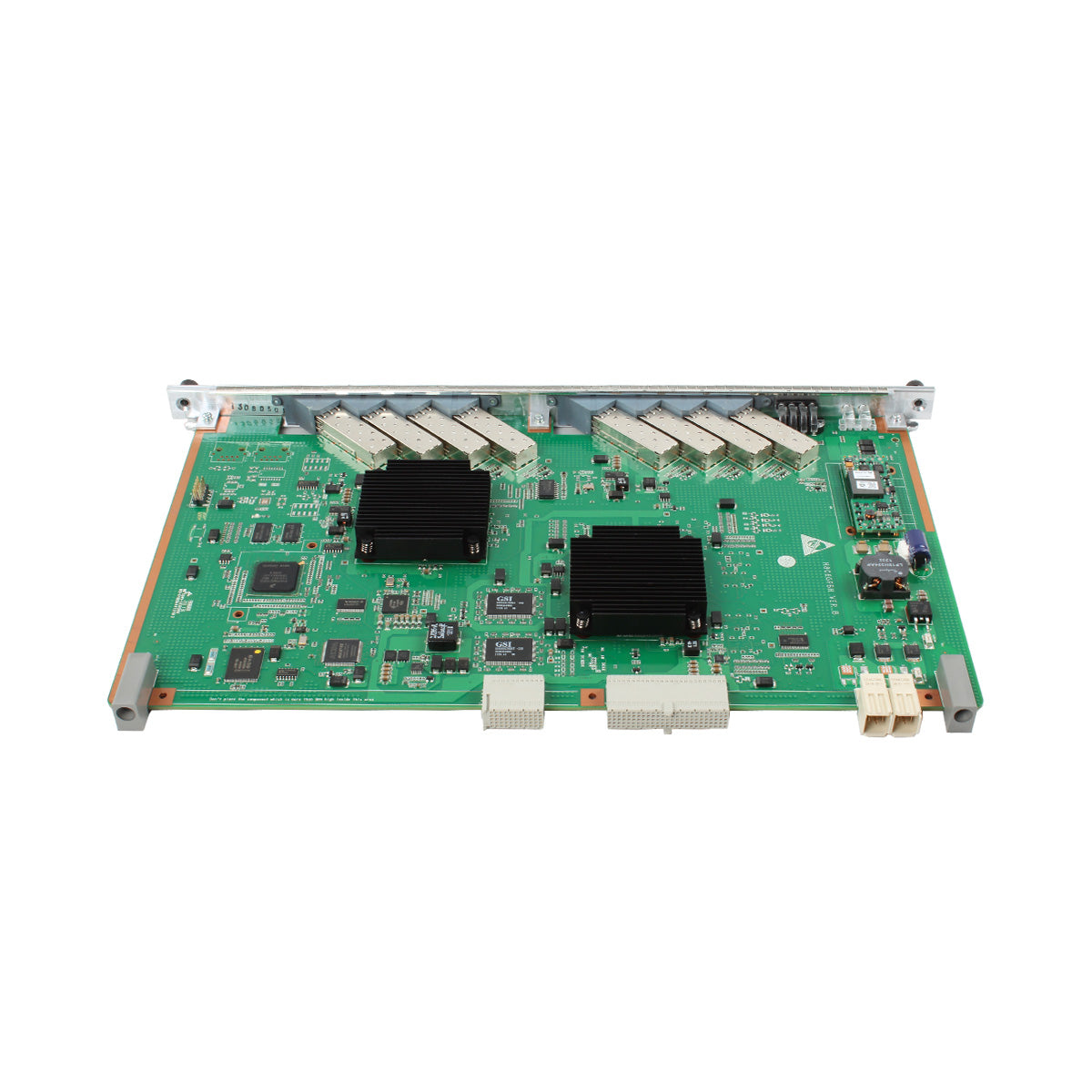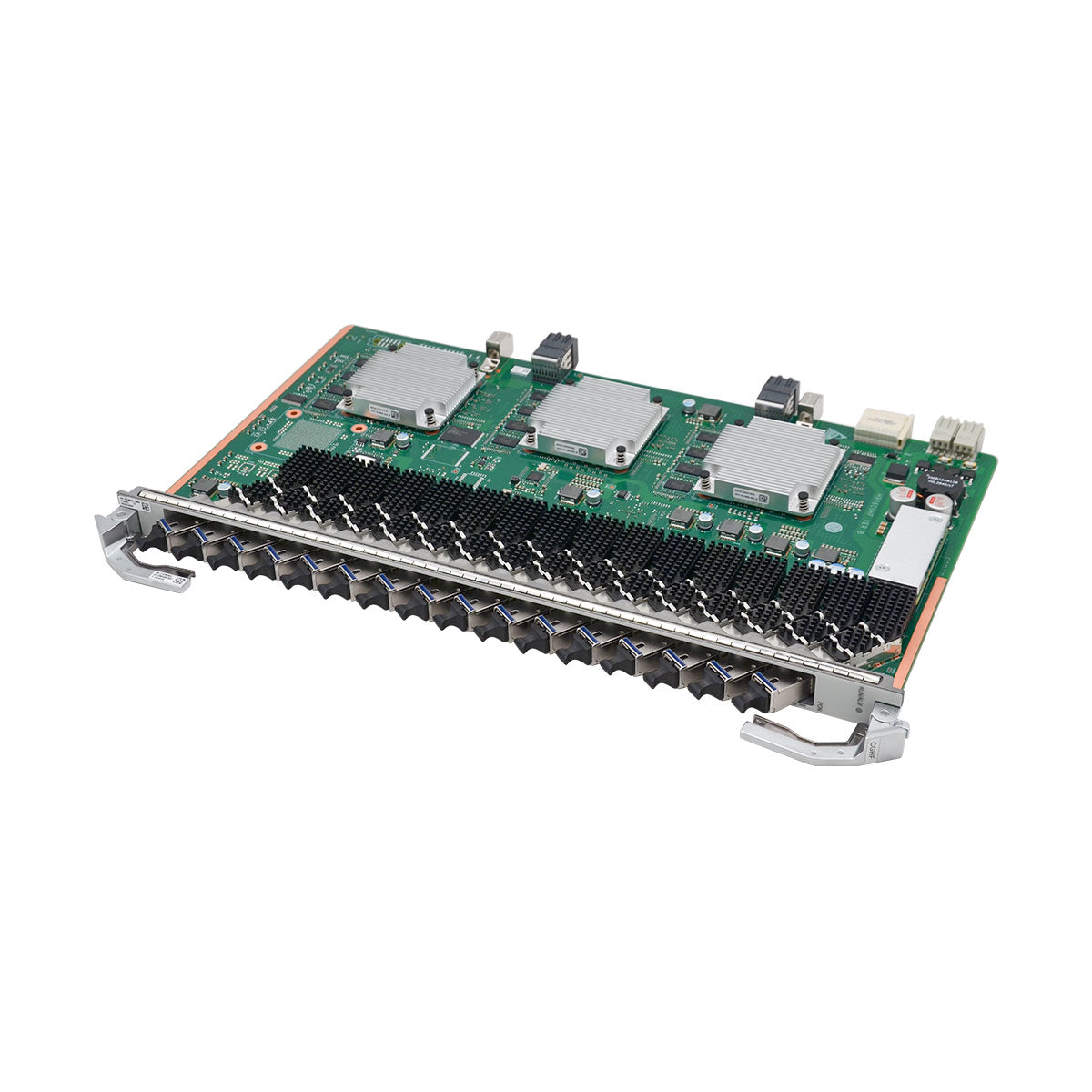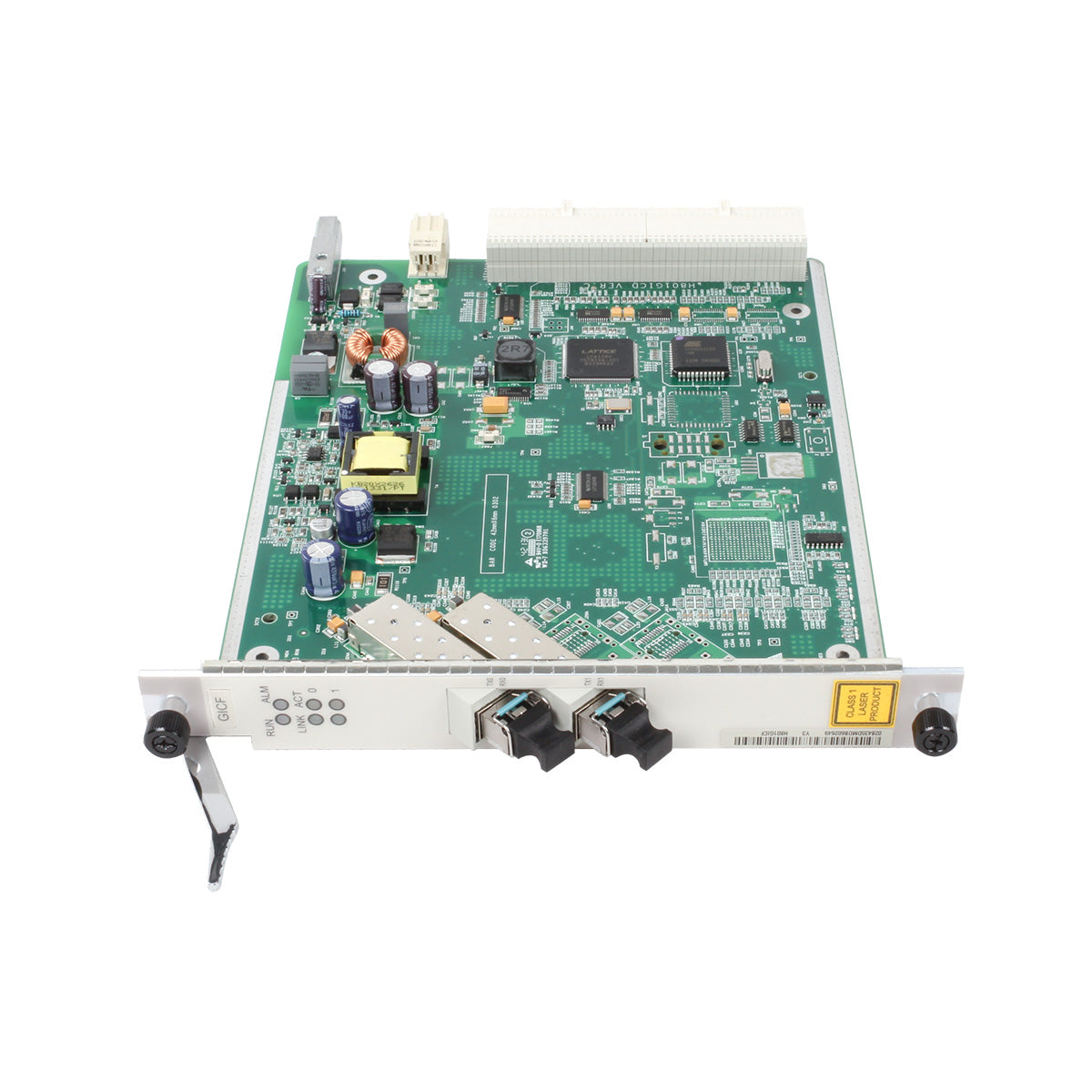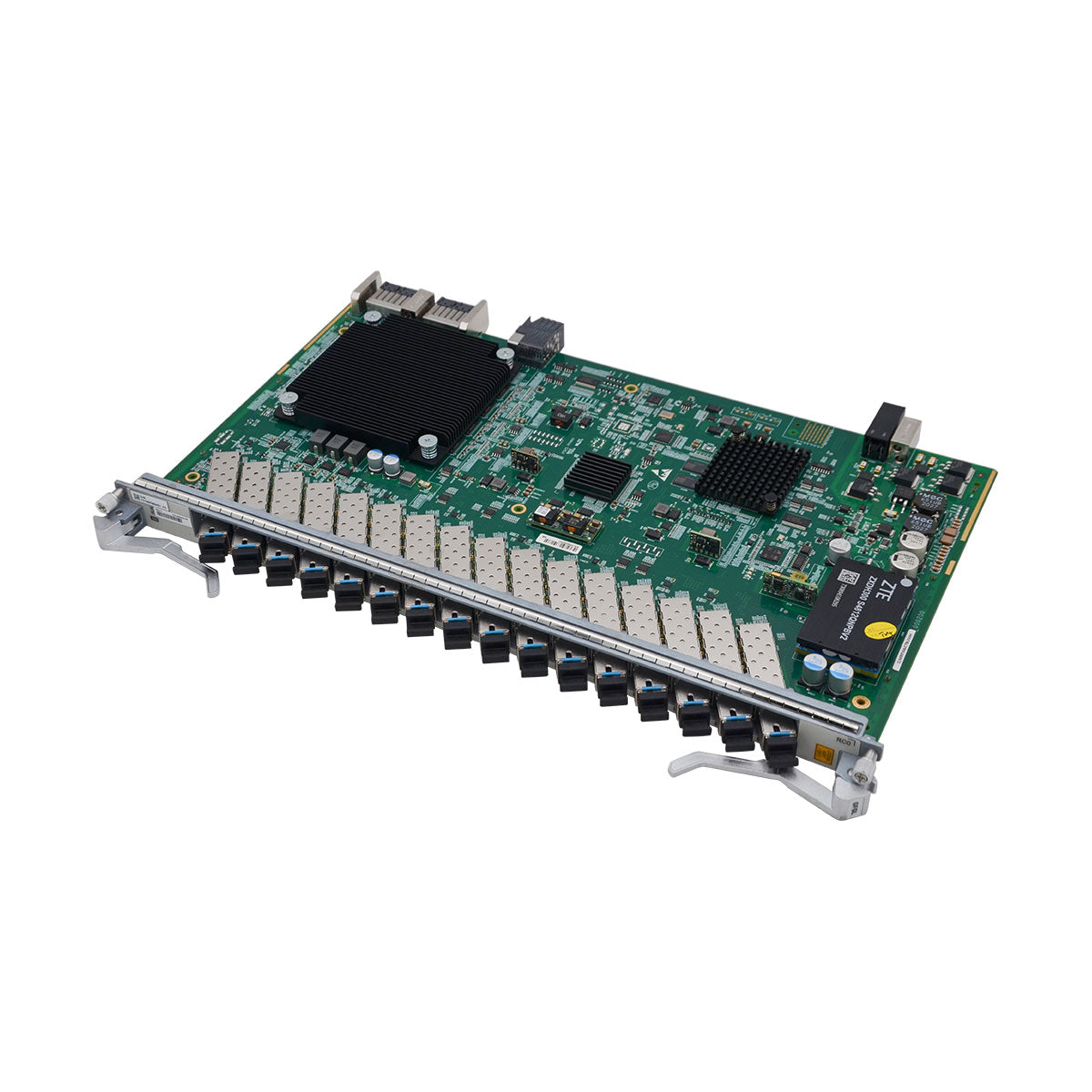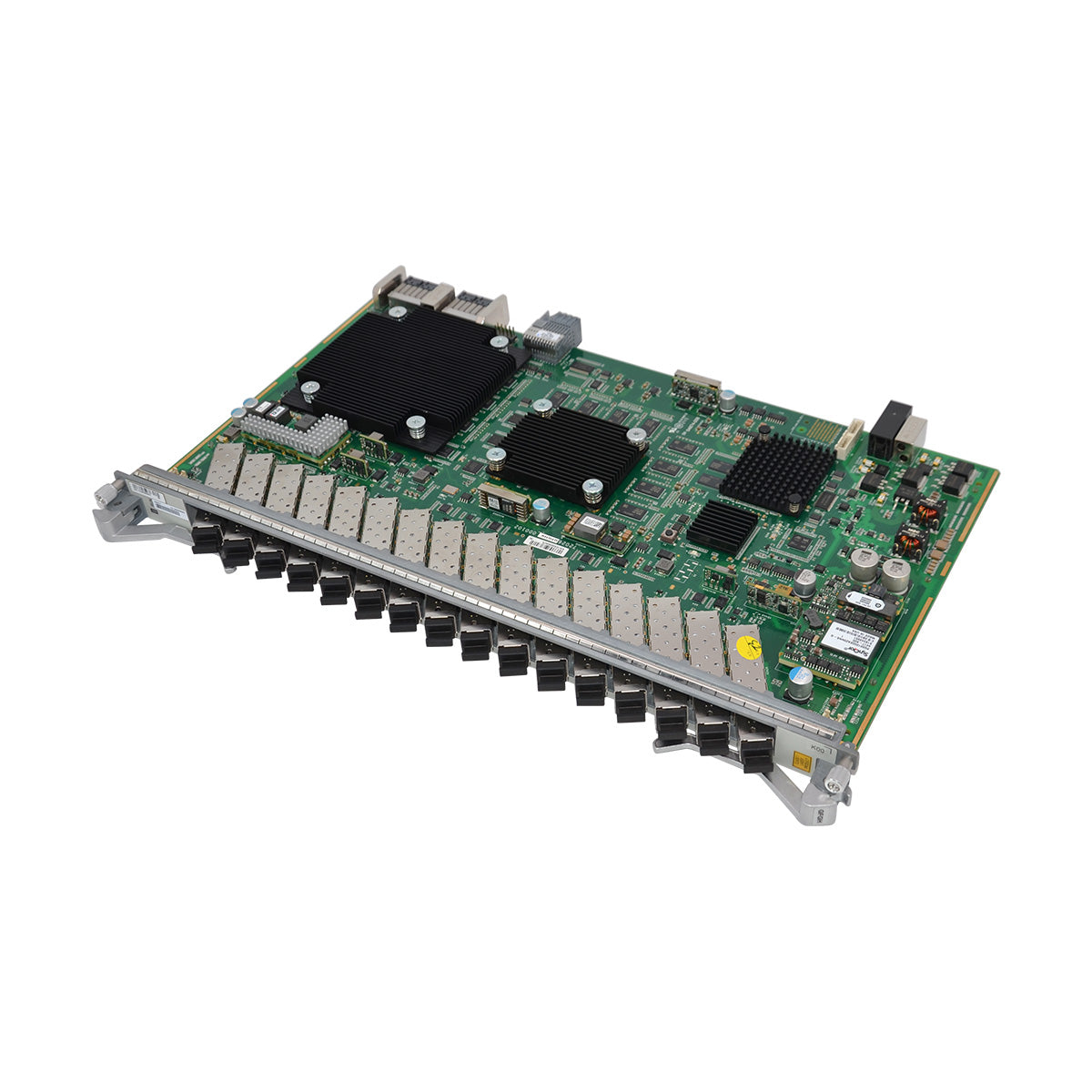Huawei SmartAX MA5616 Multi-service Access Module (MA5616 for short) is a leading remote Multi-Dwelling Unit (MDU) product
Provides various types of ports on the passive optical network (PON) and 10G PON and meets multiple service requirements
It applies in fiber to the building (FTTB) and fiber to the curb (FTTC) scenarios
It can also function as a mini-digital subscriber line access multiplexer (DSLAM) or multi-service access node (MSAN)
Supports the following users:
-A maximum of 256-channel POTS users
-A maximum of 128-channel ADSL2+ users
-A maximum of 192-channel VDSL2 users
-A maximum of 64 FE users Supports
High-speed Access:
-Vectoring cancels crosstalk between multi-pair VDSL lines.
-Vectoring increases VDSL2 line rates. -SuperVector is supported
| Specification | |
| Network-side port | CCUB: 1*GPON + 1*GE or 2*GE or 1*EPON +1*GE |
| CCUC: 1*GPON + 1*GE or 2*GE | |
| CCUD: 1*GPON + 1*GE | |
| CCUE: 2*GPON/GE Adaptive or 1*GE+1*10G GPON | |
| User-side port | 16-channel VDSL2 over POTS (Supports 8a, 8c, 8d, 12a, 12b, 17a, and 30a spectrum profiles) |
| 24-channel VDSL2 over POTS(Supports 8a, 8b, 8c, 8d, 12a, 12b, and 17a spectrum profiles) | |
| 24-channel VDSL2 over ISDN(Supports 8a, 8b, 8c, 8d, 12a, 12b, and 17a spectrum profiles) | |
| 32-channel VDSL2 over POTS(Supports 8a, 8b, 8c, 8d, 12a, 12b, and 17a spectrum profiles) | |
| 32-channel VDSL2 over POTS(Supports system-level Vectoring function.) | |
| 48-channel VDSL2(Supports 8a, 8b, 8c, 8d, 12a, 12b, and 17a spectrum profiles) | |
| 48-channel VDSL2(Supports system-level Vectoring function) | |
| 64-channel POTS board | |
| 32-channel POTS board | |
| 8-channel ISDN board | |
| 16-channel G.SHDSL board (supporting ATM and PTM) | |
| 16-channel FE (electrical) board | |
| P2P board with 4 GE (combo of optical port and electrical port) + 4 FE (optical port) | |
| 32-channel ADSL2+ board (built-in SPL) | |
| 64-channel ADSL2+ board (built-in SPL) | |
| 32-channel combo board (32 × POTS + 32 × ADSL2+) | |
| Operating temperature | -40℃ to 65℃; startup at -25℃ |
| Humidity | 5% to 95% (non-condensing) |
| Heat dissipation mode | Providing fans for heat dissipation. The rotating speed can be automatically adjusted. |
| Power supply | AC: 220 V/110 V, DC: -48 V |
| Backup power | Support for 48-V backup power Support for lead-acid batteries and LiFePO4 batteries |
| Feature List | |
| Layer 2 management | MAC address management |
| VLAN management | |
| Flow bundle | |
| Layer 2 forwarding policies: Outer VLAN+MAC forwarding | |
| Layer 2 forwarding policies: Service VLAN (S-VLAN)+customer VLAN (C-VLAN) forwarding | |
| Layer 2 isolation | |
| Layer 2 bridging | |
| Transparent transmission of protocol packets | |
| 1:1 virtual MAC address (VMAC) | |
| N:1 VMAC | |
| Quality of service (QoS) | Traffic classification policies |
| Priority processing | |
| Traffic policing | |
| Congestion control | |
| Access control list (ACL) policies | |
| Emulation services | PPPoE dialup emulation |
| Dynamic Host Configuration Protocol (DHCP) dialup emulation | |
| Call emulation | |
| Multicast service emulation | |
| Layer 3 features | DHCP Client |
| Address Resolution Protocol (ARP) | |
| Domain name service (DNS) client | |
| Static route | |
| Multicast | Internet Group Management Protocol (IGMP) version 2 or version 3 proxy and snooping |
| Multicast users | |
| Multicast logs | |
| Port-based multicast connection admission control (CAC) | |
| IPv6 | IPv6 traffic classification |
| IPv6 ACL | |
| DHCPv6 layer 2 | |
| IPv6 basic protocol stack | |
| IPv6 basic routing | |
| IPv6 neighbor discovery (ND) | |
| IPv6 security | |
| IPv6 multicast listener discovery (MLD) | |
| The CCUB control board does not support IPv6 features. | |
| Voice services | H.248 |
| Session Initiation Protocol (SIP) | |
| Semi-permanent connections (SPCs) | |
| Voice signal processing | |
| Voice service test and maintenance | |
| Reliability of voice services | |
| ISDN BRA | H.248 |
| SIP | |
| ISDN attendant system (H.248 is used) | |
| Networking features | Multiple Spanning Tree Protocol (MSTP) |
| Link Aggregation Control Protocol (LACP) | |
| Layer 2 virtual private network (L2VPN) | |
| PON type B protection | |
| GPON type C protection | |
| User security | Policy Information Transfer Protocol (PITP) |
| DHCP option 82 | |
| Relay agent info option (RAIO) | |
| MAC address anti-flapping | |
| MAC address anti-spoofing | |
| IP address anti-spoofing | |
| Access user isolation | |
| Ring check | |
| 802.1X authentication | |
| Note: The CCUB control board does not support 802.1X authentication. | |
| System security | Source MAC address filtering |
| Destination MAC address filtering | |
| Denial of service (DoS) anti-attack | |
| IP packet anti-attack | |
| Internet Control Message Protocol (ICMP) packet anti-attack | |
| Source route filtering | |
| Firewall | |
| Blacklist | |
| Permitted or denied address segment | |
| Service overload control | |
| Operation and maintenance security | SNMP |
| SSH | |
| User management | |
| Remote connection security | |
| Log management | |
| Line security | Advanced Encryption Standard (AES) 128 encryption for GPON downstream transmission |
| AES 128 encryption for 10G GPON downstream transmission | |
| Note: Only the CCUD and CCUE support AES128 encryption. | |
| Operation and maintenance features | Ethernet operations, administration and maintenance (OAM), including connectivity fault management (CFM) and Ethernet in the first mile (EFM) |
| Enabling or disabling ETH OAM 802.1ag globally | |
| Y.1731-defined CFM | |
| Y.1731-defined bidirectional diagnosis tests, including bit error rate (BER) tests | |
| Access Node Control Protocol (ANCP) | |
| Single-ended loop test (SELT) | |
| Metallic loop test (MELT) | |
| NOTE: Only the VCMM and VDMM service boards support MELT. | |
| Batch dynamic line management (DLM) performance statistics measurement | |
| Line optimization | |
| Startup time optimization | |
| Local operation and maintenance | |
| Remote operation and user management | |
| Version and data management | |
| Device exception management | |
| GPON MxU authentication | |
| Remote DHCP software commissioning for GE upstream transmission | |
| Remote network access control (NAC) software commissioning for GE upstream transmission | |
| N2510 intelligent diagnosis | |
| Clock features | Network time synchronization |
| Line clocks recovered on upstream ports | |
| Environment monitoring | Providing one environment monitoring port that supports four digital parameters (default: smoke, door status, surge protection, and main distribution frame) |
| 4830 power monitoring | |
| SMU | |
| MiniESC | |
| Mechanical Specifications | |
| Dimensions (H×W×D) | 88.1 mm x 442 mm x 245 mm (without mounting ears) |
| 88.1 mm x 482.6 mm x 245 mm (with mounting ears) | |
| Weight | 4.8 kg (empty chassis) |
| 7.2 kg (full configuration) | |
